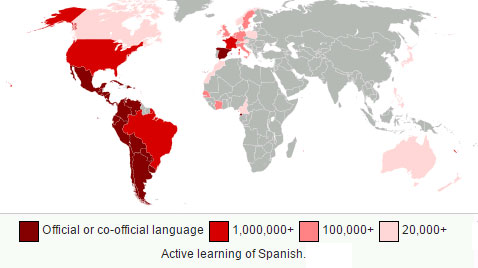
Geographic Distribution of Spanish Speakers
Below is an overview for the Geographic Distribution of Spanish Speakers.
Europe
In Europe, Spanish is an official language of Spain, the country after which it is named and from which it originated. It is widely spoken in Gibraltar, although English is the official, international language. It is also commonly spoken in Andorra, although Catalan is the official language.
Spanish is also spoken by small communities in other European countries, such as the United Kingdom, France, Italy, and Germany. Spanish is an official language of the European Union. In Switzerland, which had a massive influx of Spanish migrants in the 20th century, Spanish is the native language of 2.2% of the population.
United States
According to 2006 census data, 44.3 million people of the U.S. population were Hispanic or Hispanic American by origin; 38.3 million people, 13 percent, of the population over five years old speak Spanish at home. The Spanish language has a long history and presence in the United States due to historic Spanish and later, Mexican administration over territories now forming the southwestern states as well as Florida, which was Spanish territory until 1821.
Spanish is by far the most common second language spoken and taught in the country, and with over 50 million total speakers, the United States is now the second largest Spanish-speaking country in the world after Mexico. While English is the de facto official language of the country, Spanish is often used in public services and notices at the federal and state levels. Spanish is also used in administration in the state of New Mexico. The language also has a strong influence in major metropolitan areas such as those of Los Angeles, Miami, San Antonio, New York, San Francisco, Dallas, and Phoenix; as well as more recently, Chicago, Las Vegas, Boston, Denver, Houston, Indianapolis, Philadelphia, Cleveland, Salt Lake City, Atlanta, Nashville, Orlando, Tampa, Raleigh and Baltimore-Washington, D.C. due to 20th and 21st century immigration.
Africa
In Africa, Spanish is official (along with Portuguese and French) in Equatorial Guinea, as well as an official language of the African Union. In Equatorial Guinea, Spanish is the predominant language when native and non-native speakers (around 500,000 people) are counted, while Fang is the most spoken language by number of native speakers.
Spanish is also spoken in the integral territories of Spain in North Africa, which include the Spanish cities of Ceuta and Melilla, the Plazas de soberanía, and the Canary Islands archipelago (population 2,000,000), located some 100 km off the northwest coast of mainland Africa.
Within Northern Morocco, a former Spanish protectorate that is also geographically close to Spain, approximately 20,000 people speak Spanish as a second language, while Arabic is the de jure official language. A small number of Moroccan Jews also speak the Sephardic Spanish dialect Haketia (related to the Ladino dialect spoken in Israel). Spanish is spoken by some small communities in Angola because of the Cuban influence from the Cold War and in South Sudan among South Sudanese natives that relocated to Cuba during the Sudanese wars and returned in time for their country’s independence.
In Western Sahara, formerly Spanish Sahara, Spanish was officially spoken during the late nineteenth and twentieth centuries. Today, Spanish in this disputed territory is maintained by populations of Sahrawi nomads numbering about 500,000 people, and is de facto official alongside Arabic in the Sahrawi Arab Democratic Republic, although this entity receives limited international recognition.
Asia Pacific
Spanish is present on Easter Island, as it was annexed as a Chilean province in 1888.
Spanish was an official language of the Philippines from the beginning of Spanish rule in 1565 to a constitutional change in 1973. During Spanish colonization (1565–1898), it was the language of government, trade and education, and spoken as a first language by Spaniards and educated Filipinos. In the mid-nineteenth century, the colonial government set up a free public education system with Spanish as the medium of instruction. This increased use of Spanish throughout the islands led to the formation of a class of Spanish-speaking intellectuals called the Ilustrados. However, Spanish was never spoken by the majority of the population.
Despite American administration after the defeat of Spain in the Spanish–American War in 1898, the usage of Spanish continued in Philippine literature and press during the early years of American rule. Gradually, however, the American government began increasingly promoting the use of English, and it characterized Spanish as a negative influence of the past. Eventually, by the 1920s, English became the primary language of administration and education. But despite a significant decrease in influence and speakers, Spanish remained an official language of the Philippines when it became independent in 1946, alongside English and Filipino, a standardized version of Tagalog.
Spanish Translators
Sydney Translation provides professional English <> Spanish translation services. Our expert Spanish linguists are based in Australia and NAATI certified for professional Spanish to English translations.
To begin, use the form on this page to submit your documents for a quick quote.
Find translators – Translators Croydon, Translators Dee Why, Translators Drummoyne

